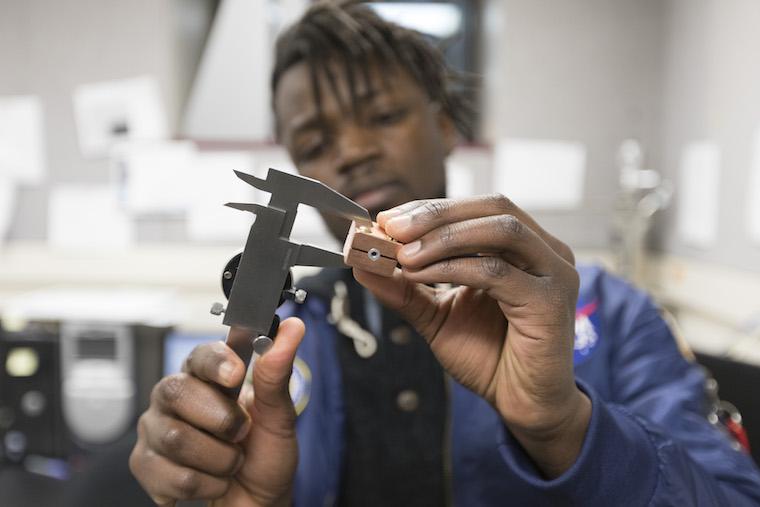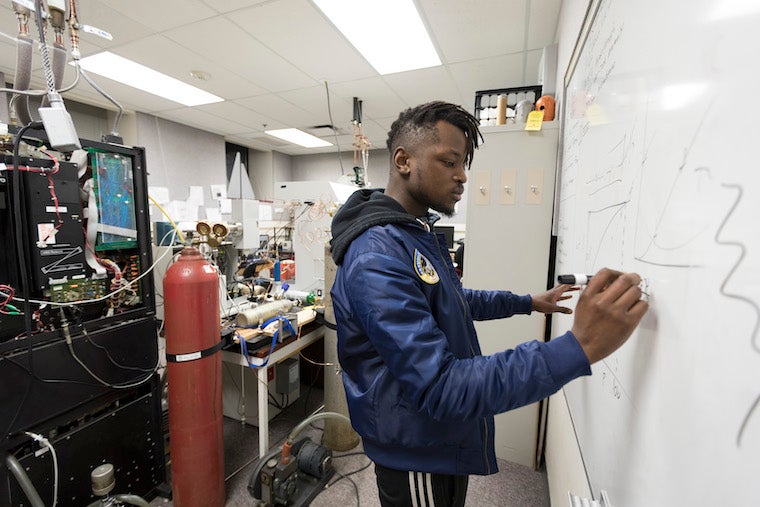Physics Lab Explores New Approach to Deuterium Separation
April 18, 2019
Jane Hobson ’22

Daniel Mukasa ’19 works in Professor of Physics Stephen FitzGerald's Lab
Photo credit: Jennifer Manna
Professor of Physics Stephen FitzGerald is conducting research to build an efficient prototype for deuterium isotope separation. His work uses quantum mechanics to perform some of the most unusual deuterium-related research currently taking place in the world.
Deuterium is an isotope of hydrogen that has various practical applications in science, medicine, and industry. Although the primary use of deuterium is as a moderator in heavy water nuclear reactors, it can be used in numerous other ways. For instance, deuterated medicine can be used to treat Huntington’s disease. Even though deuterium occurs naturally within the world’s oceans, it composes a tiny fraction of normal water, and the process commonly used to extract it is inefficient. Extracting one liter of deuterium oxide uses as much energy as the average American household uses over the course of a year.
Fourth-year physics student Daniel Mukasa explains, “The commonly used method [to extract deuterium] is not only costly, but also pumps toxic hydrogen sulfide into the environment. Separation processes like these are a huge concern for the world since they constitute 10-15 percent of the world's energy usage. So in Professor FitzGerald’s lab, we’re working on a device to separate hydrogen from deuterium in an efficient and environmentally friendly way.”
Whereas existing separation methods work with a selectivity of about two to one, the new technique developed in FitzGerald’s lab is five times more selective. So, instead of water processors pulling out twice as many deuterium atoms as hydrogens, 10 deuterium atoms are pulled out for every hydrogen atom.

Photo credit: Jennifer Manna
“The prototype we've just made enables breakthrough experiments,” Mukasa says. “It allows us to send a mixture of hydrogen and deuterium gas into a sponge-like material called a metal-organic framework, which absorbs deuterium and allows hydrogen to break through, therefore separating the two gases."
Professor FitzGerald is excited about the research. He says, “For me, it’s great because understanding quantum mechanics is an essential aspect of what we need to separate out the two compounds. And, of course, I love quantum mechanics.”
Oberlin students are encouraged to get involved in lab-based research. FitzGerald has four students assisting him in the lab, most of whom have taken classes with him or expressed interest in his lab after attending the physics department pizza lunch.
“Unique research opportunities are something we at Oberlin pride ourselves on,’’ FitzGerald says. ‘‘Most good liberal arts colleges have opportunities for students to do this type of thing, but I think this is one of the more interesting ones.”
Mukasa enjoys working in the lab. “I really love the sense of teamwork I’ve found doing research at Oberlin,” he says. “In the FitzGerald lab, we always help each other out with projects whenever we're lost. My labmate and I consistently support each other through writing our theses, and we even make sure to take occasional breaks to do rock climbing. The lab makes for a really productive and fun environment to work in.”
You may also like…
Josh Nolan Named Vice President, General Counsel, and Secretary at Oberlin
Distinguished attorney brings extensive experience in higher education law.
Learning by Teaching: Oberlin Students Share Global Music with Young Learners
College and Conservatory students in PACE 103 prepare local children for an immersive community concert at Oberlin.
Nuiko Wadden ’02 Joins Oberlin Conservatory Faculty as Assistant Professor of Harp
The versatile musician brings extensive opera, orchestral, and contemporary music experience to her role


